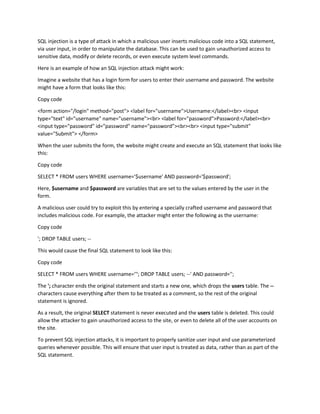
gpt.AI.docx
- 1. SQL injection is a type of attack in which a malicious user inserts malicious code into a SQL statement, via user input, in order to manipulate the database. This can be used to gain unauthorized access to sensitive data, modify or delete records, or even execute system level commands. Here is an example of how an SQL injection attack might work: Imagine a website that has a login form for users to enter their username and password. The website might have a form that looks like this: Copy code <form action="/login" method="post"> <label for="username">Username:</label><br> <input type="text" id="username" name="username"><br> <label for="password">Password:</label><br> <input type="password" id="password" name="password"><br><br> <input type="submit" value="Submit"> </form> When the user submits the form, the website might create and execute an SQL statement that looks like this: Copy code SELECT * FROM users WHERE username='$username' AND password='$password'; Here, $username and $password are variables that are set to the values entered by the user in the form. A malicious user could try to exploit this by entering a specially crafted username and password that includes malicious code. For example, the attacker might enter the following as the username: Copy code '; DROP TABLE users; -- This would cause the final SQL statement to look like this: Copy code SELECT * FROM users WHERE username='''; DROP TABLE users; --' AND password=''; The '; character ends the original statement and starts a new one, which drops the users table. The -- characters cause everything after them to be treated as a comment, so the rest of the original statement is ignored. As a result, the original SELECT statement is never executed and the users table is deleted. This could allow the attacker to gain unauthorized access to the site, or even to delete all of the user accounts on the site. To prevent SQL injection attacks, it is important to properly sanitize user input and use parameterized queries whenever possible. This will ensure that user input is treated as data, rather than as part of the SQL statement.
- 2. Save & SubmitCancel OWASP (Open Web Application Security Project) is an organization that provides resources and guidelines for improving web application security. They have published a list of the "Top 10 Most Critical Web Application Security Risks," which are the most common and most dangerous security risks faced by web applications. The current version of the list (as of September 2021) is as follows: 1. Injection: Injection attacks occur when an attacker is able to insert malicious code into a web application, usually through user input. This can be used to access sensitive data, modify or delete records, or even execute system level commands. 2. Broken authentication and session management: Web applications often require users to authenticate themselves before accessing certain features or resources. If the authentication and session management mechanisms are not properly implemented, attackers may be able to gain unauthorized access to these resources. 3. Cross-site scripting (XSS): XSS attacks occur when an attacker is able to inject malicious code into a web page, which is then executed by other users when they visit the page. This can be used to steal sensitive information, such as login credentials, or to redirect users to malicious websites. 4. Insecure direct object references: Web applications often use direct object references, such as URLs or file names, to access resources. If these references are not properly secured, attackers may be able to access resources that they should not have access to. 5. Security misconfiguration: Web applications often have many configuration options, such as security settings, database settings, and application server settings. If these are not properly configured, it can leave the application vulnerable to attack. 6. Sensitive data exposure: Web applications often store and transmit sensitive data, such as financial information, personal data, and intellectual property. If this data is not properly secured, it can be accessed by unauthorized parties. 7. Cross-site request forgery (CSRF): CSRF attacks occur when an attacker is able to trick a user into making a request to a web application that they did not intend to make. This can be used to perform actions on behalf of the user, such as changing their password or transferring money. 8. Using components with known vulnerabilities: Web applications often use third-party components, such as libraries and frameworks, to add functionality. If these components have known vulnerabilities, the application may be at risk. 9. Insufficient logging and monitoring: Web applications should keep logs of important events, such as user logins and resource accesses. If these logs are not properly maintained, it can make it difficult to detect and respond to security incidents.
- 3. 10. Failure to restrict URL access: Web applications often have different levels of access, with some resources only accessible to certain users or groups. If these restrictions are not properly implemented, attackers may be able to access resources that they should not have access to. To protect against these risks, it is important to follow best practices for web application security, such as input validation, proper authentication and authorization, and secure coding practices. It is also important to regularly test and monitor web applications to identify and address any vulnerabilities.